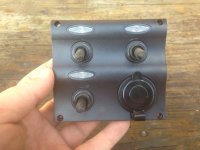I am in the process of adding some aux lighting to my tractor. I know just enough about this type stuff to be dangerous and usually learn by trial and error. (Aka "f'ing something up, scraping half a day work and starting over") I'm trying to do this right the first time.
I need help figuring out if the fused switch panel pictured below is up to the task and what size wire to run to it.


It has two 15a fuses, two switches on one and a switch / power plug on the other.
How many 27w LED lights will a single 15a fuse handle?
The battery is about 11' in a straight line from where the switch panel will be, so by the time I snake the wire through the tractor it will probably be about 15' of wire. What size wire should be used between battery and panel, and what size fuse should I put at the battery end?
Thanks in advance, and please don't laugh too hard at my ignorance. I'm a farmer, not an electrician.
I need help figuring out if the fused switch panel pictured below is up to the task and what size wire to run to it.


It has two 15a fuses, two switches on one and a switch / power plug on the other.
How many 27w LED lights will a single 15a fuse handle?
The battery is about 11' in a straight line from where the switch panel will be, so by the time I snake the wire through the tractor it will probably be about 15' of wire. What size wire should be used between battery and panel, and what size fuse should I put at the battery end?
Thanks in advance, and please don't laugh too hard at my ignorance. I'm a farmer, not an electrician.